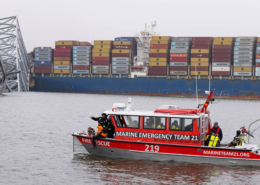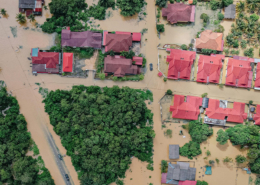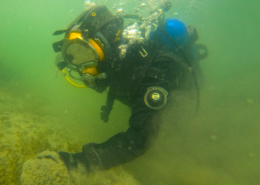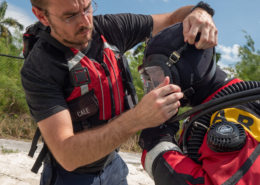Go Ahead Throw Your Weapon Over a Bridge, We’ll Find It
By: Jay White
A study into the rating of dog breeds by intelligence put numerous breeds of dogs through various intelligence tests. One of the tests that was scored involved having the dogs play with a ball, then right in front of them the ball would be covered up with a blanket. The top score was awarded to the dogs who pulled the blanket off the ball in order to continue to play with it. The next highest score was given to the dogs who crawled under the blanket to get the ball and the lowest score went to those who tried to pick the ball up through the blanket. Then came the Irish Setter. When the test was conducted on the Setter, once the ball was covered the Irish Setter forgot it was there.
Sometimes it seems that those individuals who try to hide or dispose of evidence in the water may be secretly hoping Public Safety Dive Teams are the human version of Irish Setters. Put it out of sight and hopefully it will be out of mind. As one of the easiest ways to access water in order to dispose of items in the water is to toss things off a bridge, PSD teams seem to spend a lot of time searching around bridges. As such, teams have developed and shared amongst themselves the following totally incomplete list of “DO’s” and “DON’T’s” to help be successful in finding those weapons thrown off bridges.
DO
Know your search area. How far can someone throw something off a bridge? Of course it depends on the object. A cell phone or knife can be thrown much farther than a gun, so it depends on what you are looking for. While a gun may land over 100’ from where it was thrown, a body tied down with cinder blocks thrown off a bridge lands much closer. Having a couple people on the team throw items of similar size to the items you are looking for off the bridge with spotters at the water level marking where they land on shore will give you an indication of your search area. Then go just a bit further than that. In the case of the aforementioned body, DO NOT start throwing the smallest team member off the bridge to see where they land. In spite of what they say, they really do not like it. Some teams have been known to throw golf balls off the bridge and then search until they find them, using the balls as the outside edge of the search area.
DON’T
Only search one side of the bridge, even if the investigators say so. Unless there is a witness who saw the thing go in the water, don’t assume the suspect didn’t cross the bridge and throw it off the other side. The tendency of people is to think ‘downstream’ from the bridge but that is not always the case. Without specific information, the dive plan should be based on the assumption that the last known point (the bridge) is the middle of your search area, not one end of it.
DO
Search the shallows and the banks above the water line. It is normal for the shoreline to be searched by an investigator, police dogs or search teams, but sometimes due to the shape or features of the river bank and/or the plant growth along the banks, these areas can be best searched from the water. Spending a couple days diving around a bridge while looking for a key piece of evidence in a case only to have the object spotted on the edge of the river bank by someone standing on the bridge can be… let’s just say ‘a little awkward.’
DON’T
Forget to look directly under the bridge. There is no guarantee that the weapon got thrown away from the bridge, or that it did not get carried in under the decking of the bridge and will be directly underneath the actual structure. Ensuring that the area underneath the bridge structure is cleared just as well as the rest of the search area is vitally important.
DO
Pick the best search pattern for the bridge and river location. There are far too many variables for there to be one all-encompassing search technique that will work to effectively clear all searches around bridges. With a crystal clear 5’ deep glacial fed mountain river, a team may be able to search with a number of members shoulder to shoulder with mask and snorkels allowing them to search wide areas with each pass. In a deeper river with less visibility that will not work and perhaps a Tyrolean Highline with a sled set-up is the best method. For massive wide rivers, a more methodical line tended search may be required. This is not even taking into account the currents. As the speed of the river will play a big factor in the type of search techniques used, different search techniques may be required at the same bridge during different seasons. Talking about the various issues with diving in currents is a whole article (and course) on its own.
DON’T
Assume that because the item was reportedly tossed in the previous day that it will be a visual search. As well as searching, if the team is unfamiliar with the bottom the first divers in the water should make observations on the river bottom. Not only bottom type but how ‘dynamic’ the river bottom is. It is not unusual when in rivers with unstable bottoms to see small pebbles rolling downstream or see sediment streaming off the tops of ridges like drifting snow. In an environment like this it is possible for something to become completely covered in a short period of time. A test item of similar size to the object looked for, placed in a marked location in the river and checked periodically may provide key information on the time and speed of something being covered. Tests on location such as this, properly documented with observations and photos if possible, may also assist a team member in their testimony when a defense lawyer makes an issue that the item located “must have been in the water for a long time” when the diver who located it testifies at trial that the item was covered in silt or partially buried. A knife laying on a soft bottom can be hard to see with even a small layer of slit on top of it. Remember that recently thrown in items will not necessarily be shiny.
DO
Be cognizant of the many hazards around bridges. From construction debris during the build, trees and logs piled up against bridge piers to torn metal flashing and exposed rebar on the bottom all pose a potential danger to divers in the water. And shopping carts. For some inexplicable reason that no one is talking about, a Lemming-like epidemic is ongoing where shopping carts seem to be throwing themselves off bridges everywhere at an alarming rate. These fouling hazards can affect a diver’s ability to conduct a good search pattern and will often become catchment basins for other debris flowing downstream.
DON’T
Be afraid to adjust and update the dive plan. Previously undetected obstructions such as bottom topography, bottom type or river bottom vegetation may all require what initially was a great dive plan to be amended and updated to ensure the area will be searched as effectively and safely as possible. Just because a plan has to be changed does not mean it was a faulty plan, it only means with the new information learned it is no longer the BEST option
DO
Take good notes. While this may seem obvious it cannot be mentioned often enough. The purpose of the search is not to just find the weapon, but to find the weapon, seize it in a manner that it can be properly examined and ultimately have it entered into evidence in court. Notes often include physical observations such as depth, visibility, distance from shore and distance from the bridge structure to provide investigators, judges and juries with a complete picture on where the item was located. Do not be afraid to provide some details on the search methods used including how each area was covered sufficiently, why plans were changed and other non-related objects located during the search. This information will assist investigators and attorneys on both sides to understand how the divers methodically searched the area and located the item and why, if someone throws a weapon off a bridge, the dive team will find it.
DON’T
Write me a bunch of scathing messages about how your Irish Setter “Red” is the smartest dog in the entire world. I am sure they are ‘Lassie’ reincarnated and if she had opposable thumbs she could take a potato and a piece of string and build a helicopter. I love Irish Setters, I think they are awesome dogs and great companions. But if Red can’t seem to find his favorite toy, try looking under the blanket.


 Photo By: Defense Visual Information Distribution Service
Photo By: Defense Visual Information Distribution Service


 Y. ZIN
Y. ZIN


השאירו תגובה
רוצה להצטרף לדיון?תרגישו חופשי לתרום!